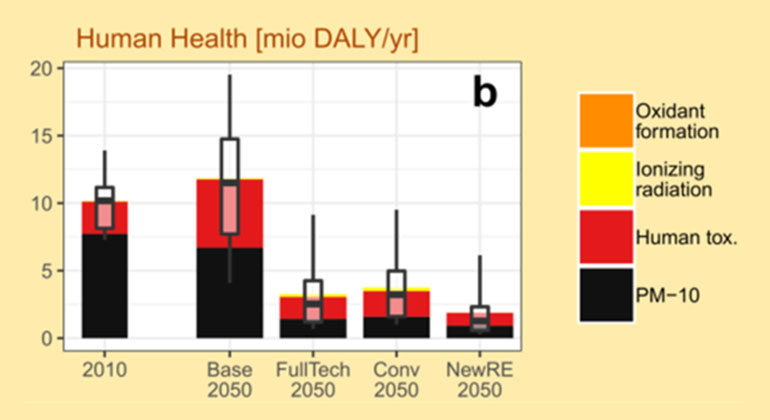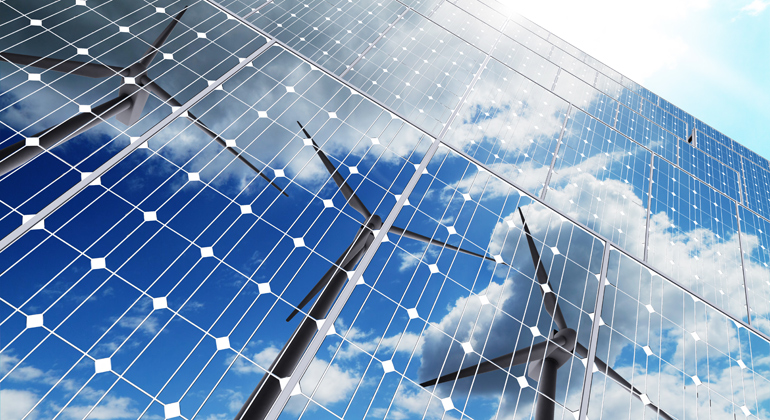Decarbonizing the power sector: renewable energy offers most benefits for health and environment
Electricity supply is one of the biggest CO2 emitters globally. To keep global warming well below 2°C, several paths lead to zero emissions in the energy sector, and each has its potential environmental impacts – such as air and water pollution, land-use or water demand.
Using a first-time combination of multiple modelling systems, an international team of researchers led by the Potsdam Institute for Climate Impact Research (PIK) has now quantified the actual benefits and downsides of three main roads to decarbonisation. They show that relying mainly on wind and solar would bring most co-benefits for the health of people and planet. Switching to carbon capture and storage in combination with fossil and biomass resources, in turn, is likely to convey significant environmental costs by devouring large areas at the cost of biodiversity, and by releasing pollutants to the environment.
“When looking at the big picture –from the direct emissions of power installations, to the mining of minerals and fuels for their construction and operation, to the lands necessary for the energy supply infrastructure – we found that the best bet for both people and environment is to rely mainly on wind and solar power,” Gunnar Luderer explains. He is lead author and deputy chair of PIK’s research domain on transformation pathways. “The main winner of decarbonisation is human health: switching to renewables-based electricity production could cut negative health impacts by up to 80 per cent. This is mainly due to a reduction of air pollution from combusting fuels. What is more, the supply chains for wind and solar energy are much cleaner than the extraction of fossil fuels or bioenergy production.”
Comparing three scenarios with two pairs of analytical spectacles
For their study published in Nature Communications, the authors compared three scenarios of decarbonising the power sector by 2050: One focused mainly on solar and wind power, a second relying mainly on carbon capture and storage in combination with biomass and fossils, and a third route with a mixed technology portfolio. In all scenarios, land use requirements for power production will increase in the future. By far the most land-devouring method to generate electricity is bioenergy. “Per kilowatt hour of electricity from bioenergy, you need one hundred times more land than to harvest the same amount from solar panels”, Alexander Popp, head of the land use management group at the Potsdam Institute, lays out. “Land is a finite resource on our planet. Given the growing world population with a hunger for both electricity and for food, pressures on the land and food systems will increase, too. Our analysis helps to get the magnitudes right when speaking of the at times much-hailed technology of bioenergy.”
The researchers used complex simulations sketching out the possible paths of decarbonising the electricity supply (Integrated Assessment Modelling) and combined their calculations with life cycle analyses. Anders Arvesen from the Norwegian University of Science and Technology (NTNU) says: “In combining two pairs of analytical spectacles, we were able to look at a wide range of environmental problems, from air pollution to toxicants, from finite mineral resources needed to manufacture wind turbines to the extent of lands transformed into bioenergy plantations if relying on negative emissions. This is a promising approach also to tackle other sectors, like buildings or the transport sector.“
“Shifting from a fossil resource base to a power industry that requires more land and mineral resources”
“Our study delivers even more very good arguments for a rapid transition towards a renewable energy production. However, we need to be aware that this essentially means shifting from a fossil resource base to a power industry that requires more land and mineral resources,” adds Luderer. “Smart choices are key to limiting the impact of these new demands on other societal objectives, such as nature conservancy, food security, or even geopolitics.”
- Article: Gunnar Luderer, Michaja Pehl, Anders Arvesen, Thomas Gibon, Benjamin L. Bodirsky, Harmen Sytze de Boer, Oliver Fricko, Mohamad Hejazi, Florian Humpenöder, Gokul Iyer, Silvana Mima, Ioanna Mouratiadou, Robert C. Pietzcker, Alexander Popp, Maarten van den Berg, Detlef van Vuuren, Edgar G. Hertwich (2019): Environmental co-benefits and adverse side-effects of alternative power sector decarbonization strategies. Nature Communications [DOI: 10.1038/s41467-019-13067-8] Web link to the article: https://www.nature.com/articles/s41467-019-13067-8
- Previous related research: Michaja Pehl, Anders Arvesen, Florian Humpenöder, Alexander Popp, Edgar Hertwich, Gunnar Luderer (2017): Understanding Future Emissions from Low-Carbon Power Systems by Integration of Lice Cycle Assessment and Integrated Energy Modelling. Nature Energy [DOI: 10.1038/s41560-017-0032-9] (see press release here)









